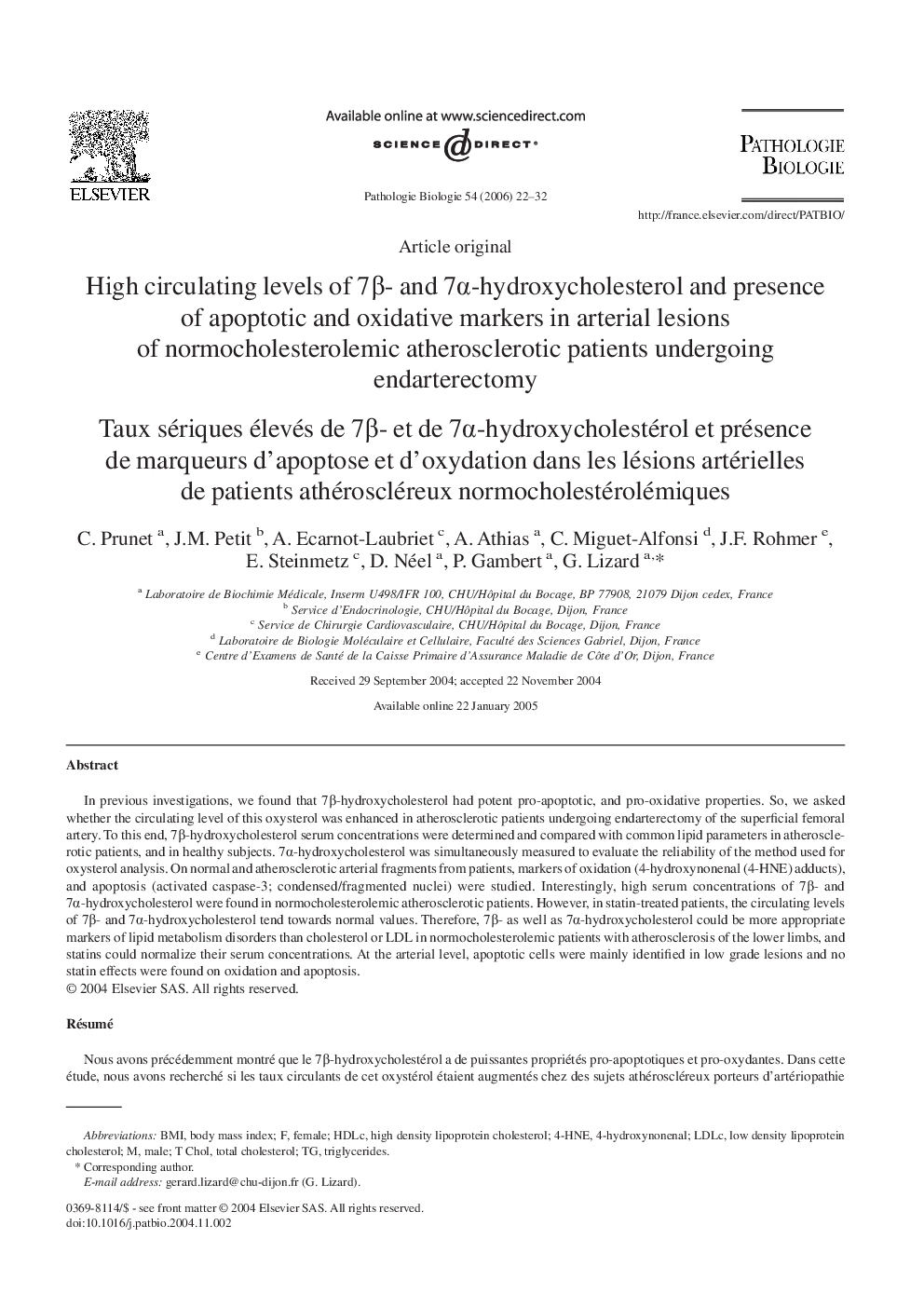| کد مقاله | کد نشریه | سال انتشار | مقاله انگلیسی | نسخه تمام متن |
|---|---|---|---|---|
| 4136917 | 1271958 | 2006 | 11 صفحه PDF | دانلود رایگان |

In previous investigations, we found that 7β-hydroxycholesterol had potent pro-apoptotic, and pro-oxidative properties. So, we asked whether the circulating level of this oxysterol was enhanced in atherosclerotic patients undergoing endarterectomy of the superficial femoral artery. To this end, 7β-hydroxycholesterol serum concentrations were determined and compared with common lipid parameters in atherosclerotic patients, and in healthy subjects. 7α-hydroxycholesterol was simultaneously measured to evaluate the reliability of the method used for oxysterol analysis. On normal and atherosclerotic arterial fragments from patients, markers of oxidation (4-hydroxynonenal (4-HNE) adducts), and apoptosis (activated caspase-3; condensed/fragmented nuclei) were studied. Interestingly, high serum concentrations of 7β- and 7α-hydroxycholesterol were found in normocholesterolemic atherosclerotic patients. However, in statin-treated patients, the circulating levels of 7β- and 7α-hydroxycholesterol tend towards normal values. Therefore, 7β- as well as 7α-hydroxycholesterol could be more appropriate markers of lipid metabolism disorders than cholesterol or LDL in normocholesterolemic patients with atherosclerosis of the lower limbs, and statins could normalize their serum concentrations. At the arterial level, apoptotic cells were mainly identified in low grade lesions and no statin effects were found on oxidation and apoptosis.
RésuméNous avons précédemment montré que le 7β-hydroxycholestérol a de puissantes propriétés pro-apoptotiques et pro-oxydantes. Dans cette étude, nous avons recherché si les taux circulants de cet oxystérol étaient augmentés chez des sujets athéroscléreux porteurs d'artériopathie oblitérante des membres inférieurs ayant subi une endartérectomie de l'artère fémorale superficielle. Les concentrations sériques de 7β-hydroxycholestérol ont été déterminées chez ces patients athéroscléreux et chez des sujets sains, et comparées avec les paramètres lipidiques courants. Le 7α-hydroxycholestérol a aussi été quantifié pour évaluer la fiabilité de la méthode de dosage des oxystérols. Chez les patients athéroscléreux, des marqueurs d'oxydation (4-hydroxynonénal (4-HNE)) et d'apoptose (caspase-3 active, noyaux condensés et/ou fragmentés) ont également été évalués sur des coupes histologiques d'artères saines et pathologiques. Les concentrations sériques de 7β- et de 7α-hydroxycholestérol sont élevées chez les patients athéroscléreux malgré des taux de cholestérol normaux. Cependant, chez les patients traités par une statine (atorvastatine ou pravastatine), les taux sériques de 7β- et de 7α-hydroxycholestérol tendent vers des valeurs normales. Ainsi, le 7β- et le 7α-hydroxycholestérol pourraient être des marqueurs plus appropriés des désordres du métabolisme lipidique que le cholestérol chez des patients normocholestérolémiques porteurs d'artériopathie oblitérante des membres inférieurs. Par ailleurs, les statines seraient à même de normaliser les concentrations sériques de 7β- et de 7α-hydroxycholestérol. Au niveau artériel, les cellules apoptotiques sont essentiellement identifiées dans les lésions précoces et les statines semblent n'avoir aucun effet sur l'oxydation et l'apoptose vasculaires.
Journal: Pathologie Biologie - Volume 54, Issue 1, February 2006, Pages 22–32